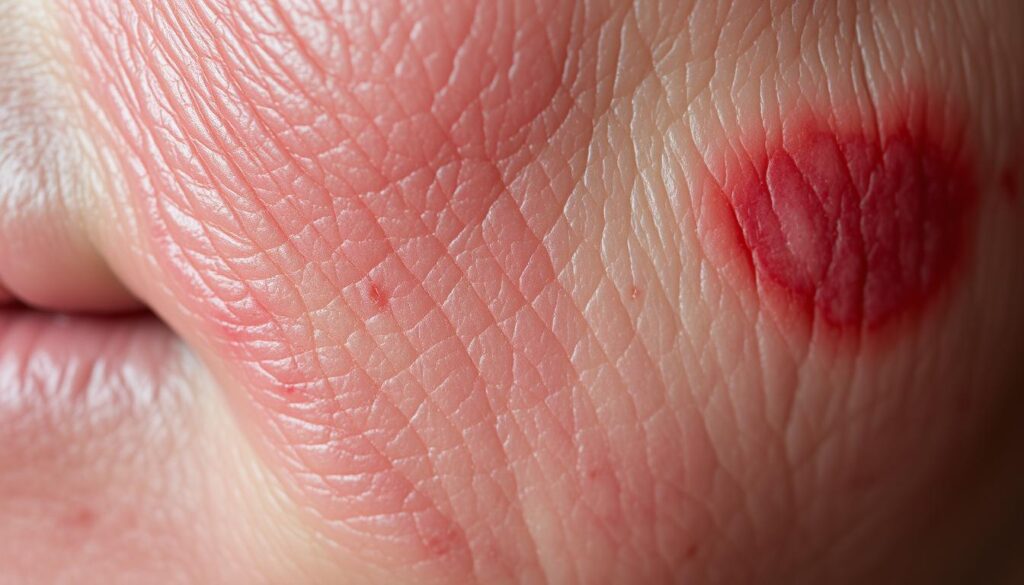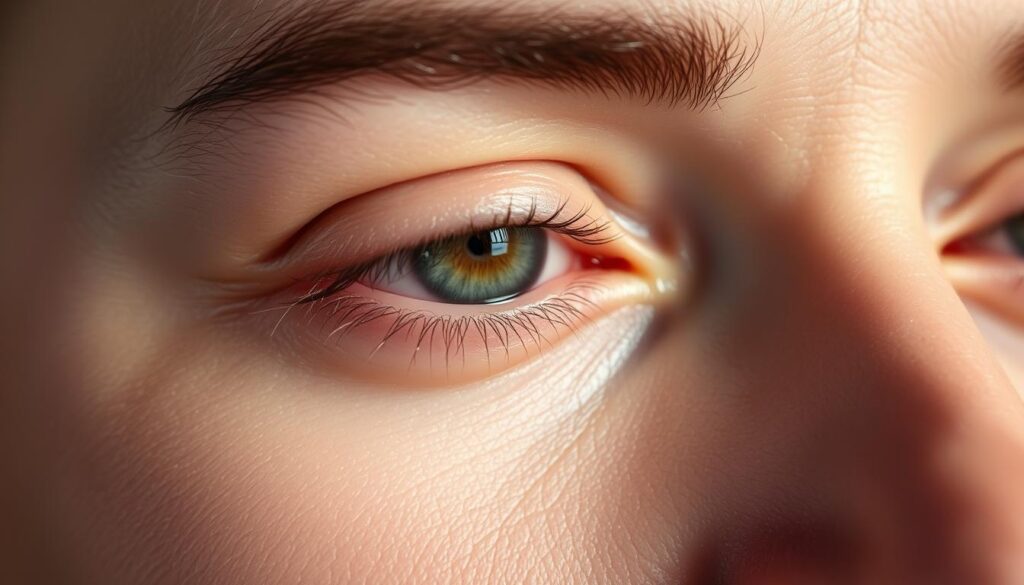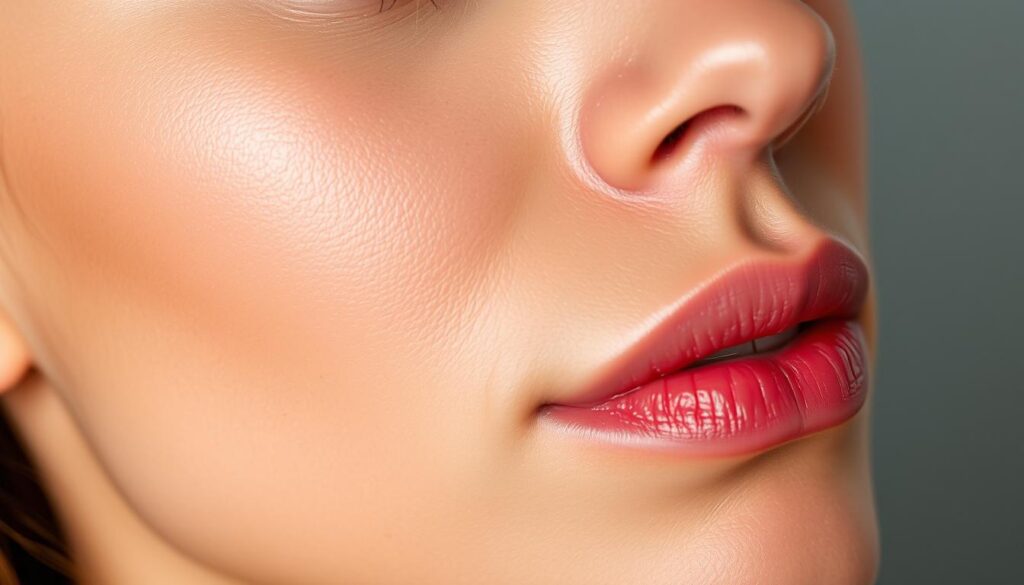Have you ever noticed your face turning red after a day in the sun or during a workout? This common issue, often referred to as skin redness, can stem from various factors like sunburn, infections, or allergies. Understanding the root cause is essential for finding the right treatment.
Increased blood flow is your body’s natural response to irritation or injury. For those with sensitive skin, this reaction can be more pronounced. Conditions like rosacea affect millions, leading to persistent redness and discomfort1. Similarly, eczema and psoriasis are other common culprits that can leave your skin feeling irritated and looking red2.
This article will guide you through the most common triggers of skin redness and share practical tips to calm your complexion. You’ll also learn when it’s time to consult a professional and how to build a gentle skincare routine. Let’s dive in and take control of your skin’s health!
Understanding Skin Redness
Ever wondered why your complexion turns red after certain activities? This reaction is often your body’s way of responding to irritation or injury. When your skin encounters an irritant, it sends extra blood to the affected area to help heal and protect it3.
The Role of Increased Blood Flow
Increased blood flow is a natural defense mechanism. For example, after a sunburn or intense workout, your skin may appear red due to the rush of blood to the surface4. This process helps deliver nutrients and oxygen to repair damaged tissue.
Recognizing Common Irritation Signs
Common signs of irritation include warmth, visible redness, and sometimes swelling. These symptoms often indicate minor injuries or exposure to irritants like harsh chemicals or allergens3. Monitoring these signs can help you decide if home remedies are enough or if you need professional care.
| Symptom | Possible Cause | Action |
|---|---|---|
| Warmth | Increased blood flow | Apply a cool compress |
| Visible redness | Irritation or injury | Use gentle skincare products |
| Swelling | Allergic reaction | Consult a doctor if severe |
Understanding these processes can help you take better care of your sensitive skin. If symptoms persist or worsen, it’s best to seek medical advice to rule out any underlying condition.
Common Causes of Skin Redness
Ever experienced a sudden flush on your face after a day outdoors? This redness can stem from various factors, including environmental influences and physical triggers. Understanding the root cause is essential to address the issue effectively.
Environmental and Physical Triggers
Environmental factors like sun exposure and harsh weather conditions can lead to redness. Prolonged time outdoors without protection may cause skin to react with a flushed appearance5. Similarly, physical triggers such as friction from clothing or heat from hot showers can irritate the skin6.
Certain chemicals in skincare products can also be a trigger. Ingredients like salicylic acid or alcohol may cause irritation, especially for those with sensitive skin5. Identifying these factors helps in preventing recurring episodes of redness.
Allergic Reactions and Irritants
Allergic reactions are another common cause. Allergens like pollen, pet dander, or specific foods can lead to redness and discomfort6. For example, some people experience reactions after consuming shellfish or nuts.
Chemical irritants in household cleaners or cosmetics can also cause skin irritation. Products containing harsh acids or fragrances may lead to allergic reactions5. Always patch-test new products to avoid unexpected redness.
By recognizing these triggers, you can take steps to protect your skin and maintain a healthy complexion.
Identifying Specific Skin Conditions
Do you struggle with persistent redness or itching on your face? These symptoms could signal a specific condition like dermatitis, eczema, or rosacea. Understanding the differences helps you manage your symptoms effectively.
Dermatitis and Eczema
Dermatitis and eczema are inflammatory conditions that often cause itching and redness. Atopic dermatitis, a type of eczema, affects 10-20% of children and 1-3% of adults globally7. These issues can appear on your face, hands, or other areas exposed to irritants.
Common triggers include harsh chemicals, allergens, and dry weather. Using a gentle skincare product can help soothe irritation and prevent flare-ups. If symptoms persist, consult a dermatologist for a tailored treatment plan.
Rosacea, Psoriasis, and Other Disorders
Rosacea is another chronic condition that primarily affects the face. It causes visible redness, flushing, and sometimes small bumps. Approximately 16 million Americans live with rosacea7. Psoriasis, on the other hand, leads to thick, scaly patches on the skin, affecting 2-3% of the global population7.
Both conditions can cause discomfort and itching. Managing them often requires a combination of prescription treatments and specialized skincare products. A professional diagnosis ensures you receive the right care for your specific needs.
| Condition | Common Symptoms | Recommended Action |
|---|---|---|
| Dermatitis | Itching, redness, dry skin | Use hypoallergenic products |
| Eczema | Inflamed patches, itching | Moisturize regularly |
| Rosacea | Facial redness, flushing | Avoid triggers like spicy foods |
| Psoriasis | Scaly patches, itching | Consult a dermatologist |
Recognizing the signs of these conditions is the first step toward relief. With the right approach, you can manage symptoms and improve your quality of life.
Medical Conditions and Infections Behind Red Skin
Have you ever noticed your face turning red unexpectedly? While many cases of redness are harmless, some signal serious medical conditions that require immediate attention. Understanding these causes can help you act quickly and seek the right treatment.

Infectious Causes like Cellulitis and Scarlet Fever
Infections like cellulitis and scarlet fever can cause redness that spreads rapidly. Cellulitis, often caused by bacteria like Streptococcus or Staphylococcus, affects around 1 in 1,000 people annually8. If untreated, it can lead to severe complications, including amputation in 3% of cases8.
Scarlet fever, another bacterial infection, often accompanies strep throat. It causes a distinctive red rash and requires prompt medication to prevent complications. Early treatment can reduce risks by up to 50%8.
Burns, Chemical Exposure, and Drug Allergies
Burns and chemical exposure can also lead to redness. First-degree burns cause mild redness, while second and third-degree burns require urgent care. Chemical burns, often from household cleaners, can damage deeper layers of the skin and need immediate attention.
Drug allergies are another serious cause. An allergic reaction to medication can result in hives, swelling, and redness. In severe cases, it can lead to anaphylaxis, a life-threatening condition. Always consult a doctor if you suspect a drug allergy.
Recognizing these signs is crucial. If you experience persistent redness with symptoms like fever, swelling, or pain, seek medical help immediately. Early intervention can prevent complications and ensure effective treatment.
Skin Redness: Causes and How to Soothe Irritation
Does your complexion often react with a flushed appearance? This common issue can stem from various factors, including environmental triggers, allergies, or underlying conditions. Understanding the cause is the first step toward finding effective treatment.
When your body encounters an irritant, it increases blood flow to the affected area. This natural response helps repair damage but can leave your face looking red. For those with sensitive skin, this reaction can be more pronounced9.
To help reduce discomfort, start with gentle care. Avoid harsh products that strip moisture from your face. Instead, opt for soothing cleansers and moisturizers designed for sensitive complexions. Over-the-counter treatments, like hydrocortisone cream, can also provide relief10.
Here are some effective techniques to calm irritation:
- Apply a cool compress to reduce heat and swelling.
- Use fragrance-free products to avoid further irritation.
- Stay hydrated to support your skin’s natural barrier.
For persistent redness, consult a dermatologist. They can recommend tailored solutions to address your specific needs. In the next section, we’ll explore home remedies that can further help reduce discomfort and restore your skin’s balance.
Effective Home Remedies to Soothe Irritation
Feeling discomfort from irritation? Simple home remedies can make a big difference. With the right approach, you can calm your body and restore balance. Let’s explore some easy-to-follow techniques to help you feel better.
Cleansing and Moisturizing Techniques
Start with a gentle cleansing routine. Use lukewarm water and a mild product to remove dirt and irritants. Avoid harsh scrubs or soaps that strip moisture. Pat your face dry with a soft towel to prevent further irritation.
Moisturizing is key to protecting your body. Look for creams with ingredients like colloidal oatmeal, which strengthens the skin barrier11. Apply moisturizer immediately after cleansing to lock in hydration. This step helps soothe dryness and reduce discomfort.
Over-the-Counter Treatments and Natural Soothers
For quick relief, consider over-the-counter options. Hydrocortisone cream can reduce swelling and itching. Always follow the instructions on the label to avoid overuse.
Natural remedies can also be effective. Coconut oil, rich in lauric acid, has antibacterial properties that help with dermatitis11. Aloe vera is another excellent choice, known for its anti-inflammatory benefits12. Apply these directly to the affected area for soothing results.
Other natural soothers include oatmeal baths and Epsom salts. Soaking for 15-30 minutes can improve moisture retention and calm irritation11. These methods are safe and gentle for most skin types.
By incorporating these remedies into your routine, you can manage irritation effectively. Remember, consistency is key to maintaining healthy skincare habits.
When to Seek Medical Help
Are you unsure when to consult a doctor about your symptoms? Recognizing the signs that require professional attention is crucial for your health. Some symptoms may indicate serious conditions that need immediate care.
Recognizing Emergency Symptoms
Certain symptoms should never be ignored. Severe pain, rapid swelling, or difficulty breathing are clear signs of an emergency. For example, a rashe that spreads quickly could indicate a severe allergy or infection13.
Persistent itching or a rashe that doesn’t improve after a week may also signal a deeper issue. If you notice these changes, it’s time to ask a question to your healthcare provider7.
Diagnostic Steps and Treatment Options
When you visit a doctor, they may perform a physical exam or run tests to identify the factor causing your symptoms. Early diagnosis can prevent complications, especially in cases like Lyme disease, which requires prompt medication13.
For conditions like cellulitis, untreated cases can lead to severe outcomes in 3% of patients7. Always follow your doctor’s advice and start treatment as soon as possible.
| Symptom | Possible Cause | Action |
|---|---|---|
| Severe pain | Infection or injury | Seek emergency care |
| Rapid swelling | Allergic reaction | Use antihistamines or epinephrine |
| Persistent itching | Eczema or dermatitis | Consult a dermatologist |
| Spreading rashe | Infection or allergy | Start prescribed medication |
Everyday Tips for Long-Term Skin Care
Maintaining a healthy complexion requires consistent effort and the right approach. A thoughtful routine can help you avoid common issues and keep your face looking its best. Let’s explore practical steps to build a gentle and effective skincare plan.
Building a Gentle Skincare Routine
Start with a simple routine that focuses on cleansing, moisturizing, and protection. Use a mild product to clean your face twice daily. Avoid harsh scrubs or soaps that can strip moisture. After cleansing, apply a hydrating moisturizer to lock in moisture and strengthen your skin barrier14.
Protection is key, especially during the day. Use a broad-spectrum sunscreen with SPF 30 or higher to shield your face from harmful UV rays. This step is crucial, as 27% of all cases of red skin are attributed to sun exposure14.
Ingredients to Embrace and Avoid
Choosing the right ingredients can make a big difference. Look for soothing components like colloidal oatmeal, aloe vera, and vitamin B3. These help reduce irritation and enhance your skin’s natural defenses14.
Avoid harsh chemicals like alcohol, sulfates, and artificial fragrances. These can trigger irritation, especially for those with sensitive skin. Always patch-test new products to ensure they suit your type of complexion15.
| Ingredient | Benefit | Example Product |
|---|---|---|
| Colloidal Oatmeal | Calms irritation | Aveeno Soothing Bath Treatment |
| Aloe Vera | Reduces inflammation | Nature Republic Aloe Vera Gel |
| Vitamin B3 | Strengthens skin barrier | CeraVe PM Facial Moisturizing Lotion |
Remember, each person’s skin is unique. Tailor your routine to your specific needs and adjust it over time. With consistent care, you can maintain a healthy and radiant complexion.
Conclusion
Taking control of your complexion starts with understanding the triggers and solutions. Whether it’s an allergic reaction, environmental factors, or a chronic condition, identifying the root cause is the first step toward effective treatment.
Mild symptoms like a rash or inflammation can often be managed with home remedies, such as cool compresses or gentle skincare products. However, persistent issues like swelling or widespread rashes may require professional care. Studies show that 30% of individuals with sensitive skin react negatively to common allergens, emphasizing the need for tailored solutions16.
Consistency is key. A daily routine that includes cleansing, moisturizing, and sun protection can prevent future flare-ups. Remember, your skin’s health is in your hands. With the right approach, you can achieve a calm, balanced complexion.



